Airglow Problems in High Source Density Scans
Overview
In anticipation of the last leg of observations we have looked over a population
of high source density scans and identified ~70 that may be suffering from
airglow problems and should possibly be reobserved as the opportunity exists
between gathering the final scans in the survey.
Background
Under current grading rules, airglow problems are identified by applying
a threshold to the H-band residual coadd noise (Hcn4) diagnostic. This
is very effective at identifying scans with airglow-induced ripples in
the backgrounds that will cause bad extended source problems (false sources
and bad photometry).
However, the reliability of this diagnostic breaks down in fields with
high source densities since confusion can make the background difficult
to model. We have not applied this Hcn4 diagnostic to fields with source
densities in excess of 4.2 (log of Ks souce counts per sq. degree)
because of this confusion problem, since high Hcn4 values can just as easily
crop up in scans with no airglow problems.
In Fig. 1 below, the scans currently falling within our airglow checks
are black (no airglow) and red (downgraded for airglow). The blue &
magenta point indicate scans at densities higher than those actively downgraded
for airglow.
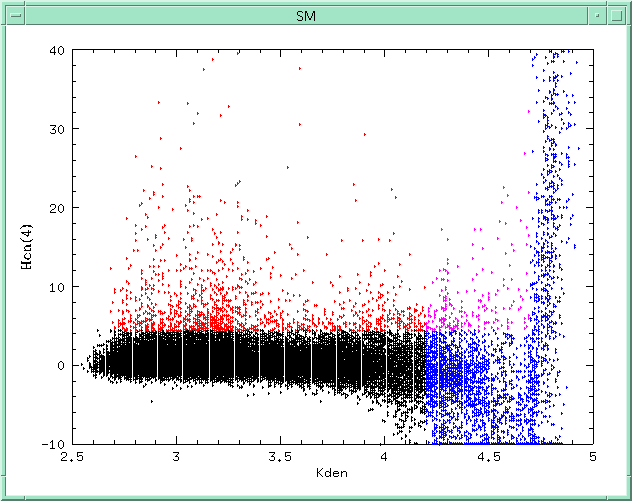
Fig 1. Hcn(4) vs. source density diagnostic. Automatic airglow downgrades
are only applied for densities < 4.2 since the coadd noise estimates
begin to break down after this. At densities > 4.7 the Hcn(4) diagnostic
blows up as the coadd noise estimates become completely dominated by source
confusion.
Identifying Airglow in High Density Scans
In an effort to identify tiles with high densities that may also be suffering
from airglow (a condition that has not been systematically attacked before
now), I have examined the frame median background (bkg) plots for all 222
scans with source densities in the range log(Kden) = 4.2-4.7 and for which
the Hcn4 value exceeds 4.5 (these scans are plotted in magenta in Fig.
1). The bkg plots are a powerful, if qualitative, indicator of airglow
conditions since they are scaled to fit the proportions of airglow variations
(i.e. airglow variations in each band will be in similar proportions).
As a result we have produced a list of ~70 scans which have likely airglow
problems. They comprise only about 30% of the total number of scans inspected.
Of these, about half have unquestionably bad airglow variations based soley
on the erratic bkg plots. The other half are marginal but quite possibly
bad. Representative bkg plots follow:
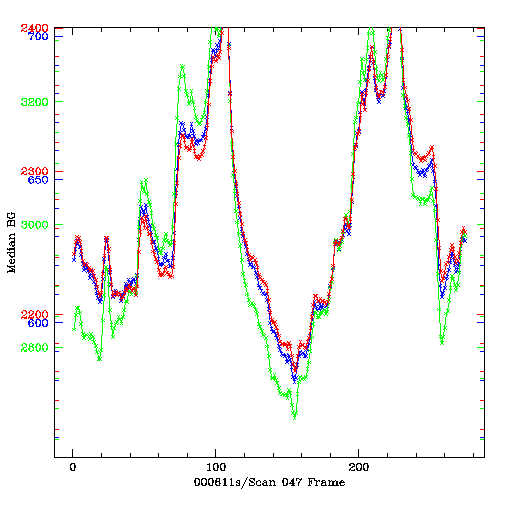
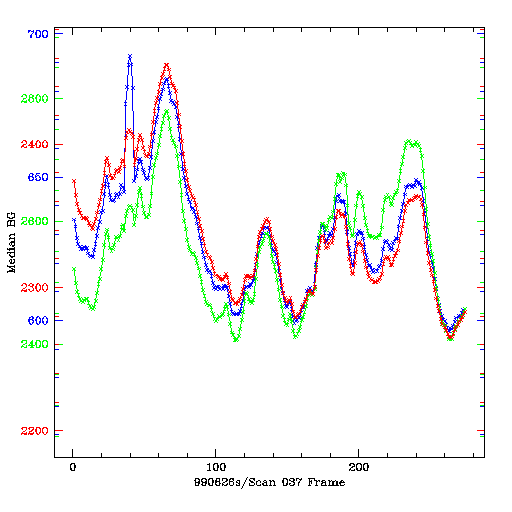
Fig. 2: Two sample "bad" aiglow bkg plots
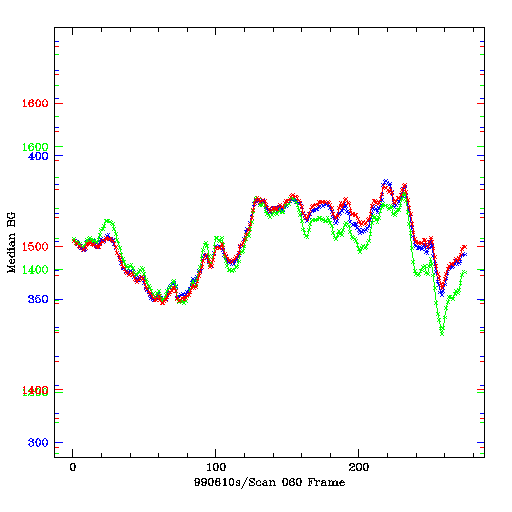
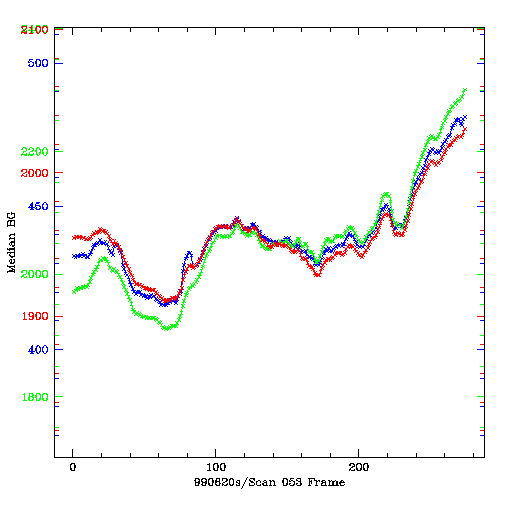
Fig. 3: Two plots with "marginal" airglow bkg plots
Following are two sets of coadd images for scans picked arbitrarily
from the list of bad and marginal tiles. Both show obvious airglow.
While only 3 coadds are displayed in this quick priview,
T. Jarrett has inspected both scans in their entirety and found significant
airglow throughout.
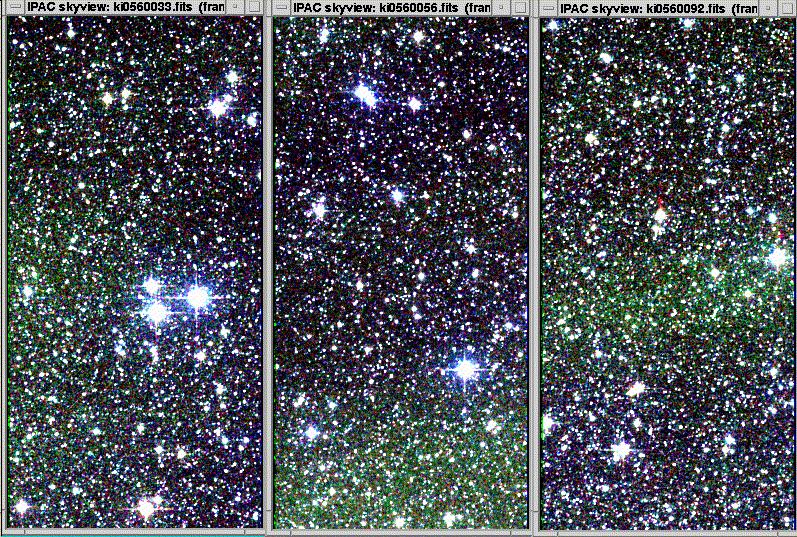
Fig. 4a: "Moderate" airglow scan 990610s 056
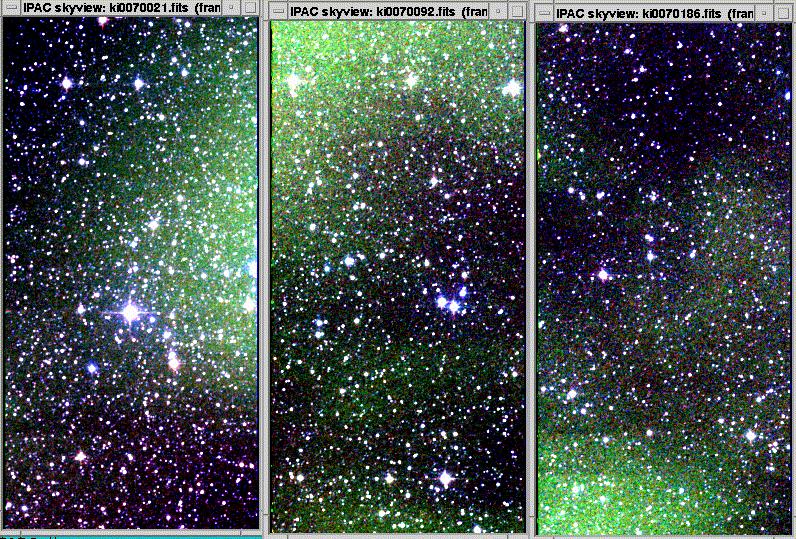
Fig 4b: "Bad" airglow scan 990726s 007
We have also inspected 3 scans from 980624s including 2 "moderate" (110-111) and
1 "bad" (112) scans. All show airglow effects throughout, with the "bad" field
consistently worse with sharp changes in background. The severity of airglow
in all of the inspected scans correlates well with the new diagnostic discussed
below.
List of suspect tiles
The first table is of the definitely bad tiles, while the second contains
the sample with marginal background plots. It is possible to further reduce
this list by inspecting coadds taken off of the image server but we have
not attempted this yet.
Bad airglow tiles
Tile DateHemi Scan Kdens Hcn4
311055 980624s 112 4.25 11.1
324473 990620s 016 4.27 17.4
324475 990620s 018 4.32 4.7
322965 990626s 037 4.51 11.9
322966 990626s 038 4.5 8.7
322967 990626s 039 4.48 5.5
322985 990626s 069 4.31 6.2
322987 990626s 071 4.3 13
322988 990626s 072 4.28 5.7
322989 990626s 079 4.28 7.4
322990 990626s 080 4.3 9.3
322997 990626s 093 4.21 5.7
323022 990724s 050 4.23 5.7
205399 990724s 094 4.28 12.3
324444 990725s 020 4.26 4.6
324415 990726s 007 4.28 6
324416 990726s 008 4.3 16.1
324417 990726s 009 4.28 11
324418 990726s 010 4.29 12.1
324442 990726s 013 4.27 6.1
324446 990726s 014 4.26 12.1
324467 990726s 021 4.3 13.5
324478 990726s 022 4.29 9.7
202412 990801s 089 4.24 6.5
202413 990801s 090 4.23 10.6
202330 990807s 075 4.57 10.3
305308 990820s 014 4.67 42.3
21266 991121n 012 4.29 7.3
324381 000126s 103 4.35 5.2
11160 000422n 092 4.61 11
326065 000423s 028 4.63 20.2
322990 000611s 047 4.26 9
322991 000611s 048 4.27 6
302368 000611s 074 4.64 7.2
322990 000717s 021 4.29 4.9
Marginal airglow tiles
Tile DateHemi Scan Kdens Hcn4
11110 970614n 098 4.28 5.3
11112 970614n 100 4.32 7.7
11167 970617n 072 4.59 9.9
11168 970617n 073 4.57 11
11187 970617n 104 4.35 5.7
308234 980416s 121 4.22 6.3
16496 980430n 085 4.33 7.3
311053 980624s 110 4.31 8
311054 980624s 111 4.28 7.3
305217 990426s 089 4.4 5.3
320840 990610s 056 4.53 5.9
320842 990610s 058 4.56 5.2
320844 990610s 060 4.59 5.9
320846 990610s 061 4.59 5
324495 990620s 051 4.32 6.7
324497 990620s 053 4.31 4.9
322976 990626s 054 4.41 5.2
322978 990626s 056 4.35 4.8
322979 990626s 057 4.38 6.8
322982 990626s 066 4.35 12.7
322983 990626s 067 4.34 5.2
322984 990626s 068 4.34 5
322986 990626s 070 4.31 4.8
322991 990626s 081 4.25 5.1
322992 990626s 082 4.24 6.2
322994 990626s 084 4.23 4.7
320962 990715s 086 4.5 5.6
205396 990721s 101 4.3 11.9
205397 990721s 102 4.28 8.4
205398 990721s 103 4.3 11.8
202409 990801s 086 4.32 4.6
205363 990804s 073 4.68 17.6
205366 990804s 076 4.62 14.7
202326 990807s 071 4.54 5.8
202328 990807s 073 4.54 9.6
202332 990807s 077 4.61 5.6
21295 991022n 017 4.27 5.6
21267 991121n 013 4.27 7.3
21268 991121n 014 4.29 7.9
21273 991121n 022 4.29 7.2
21275 991121n 024 4.27 7.5
326142 000502s 041 4.67 4.8
302367 000611s 073 4.65 18.5
Other Diagnostics
In looking over the scan characteristics of this set of visually-selected
problem tiles, there is one kind of diagnostic that correlates extremely
well with the tiles found to have airglow problems. This potential new
diagnostic is derived from the coadd banding diagnostic counters. These
tally the number of coadds in a scan found to have banding in excess of
a 5-sigma threshold based on Fourier analysis of the right and left sides
of the coadds. This was originally devised to catch J electronics banding
found early in the project, but the diagnostic also correlates well with
airglow.
In order to isolate H-band airglow problems using the Airglow Banding
Diagnostic (ABD) values, we construct a new indicator of the form:
airglow banding diagnostic = 2(Hbl + Hbr) - (Jbl + Jbr + Kbl
+ Kbr)
where the term represent the "l"eft and "r"ight banding counts for each
band. Each term can be in the range of 0-23. Banding found evenly
across all bands (i.e. not likely related to airglow) will have ABD = 0.
By subtracting the J & K banding contributions from the H contributions,
only H-strong banding seen in both halves will create large values.
The correlation between high ABD values and scans inspected for airglow
problems can be seen in the following histogram:
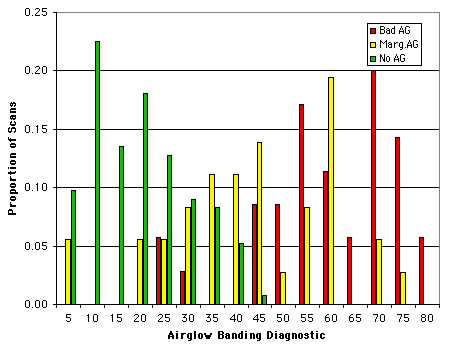
Fig. 5: Airglow banding diagnostic values for 3 populations of high
density scans. Red bins are for scans with confirmed bad airglow, yellow
bins show marginal evidence for airglow, and green bins are for scans clearly
not suffering from airglow. The distribution exhibits consistency between
the diagnostic and the visually-selected airglow sample.
This diagnostic is offered as food for thought on another possible
way to identify airglow problems. No statistics have yet been accumulated
for low density scans.
page last updated 9/6/00 by R. Hurt







